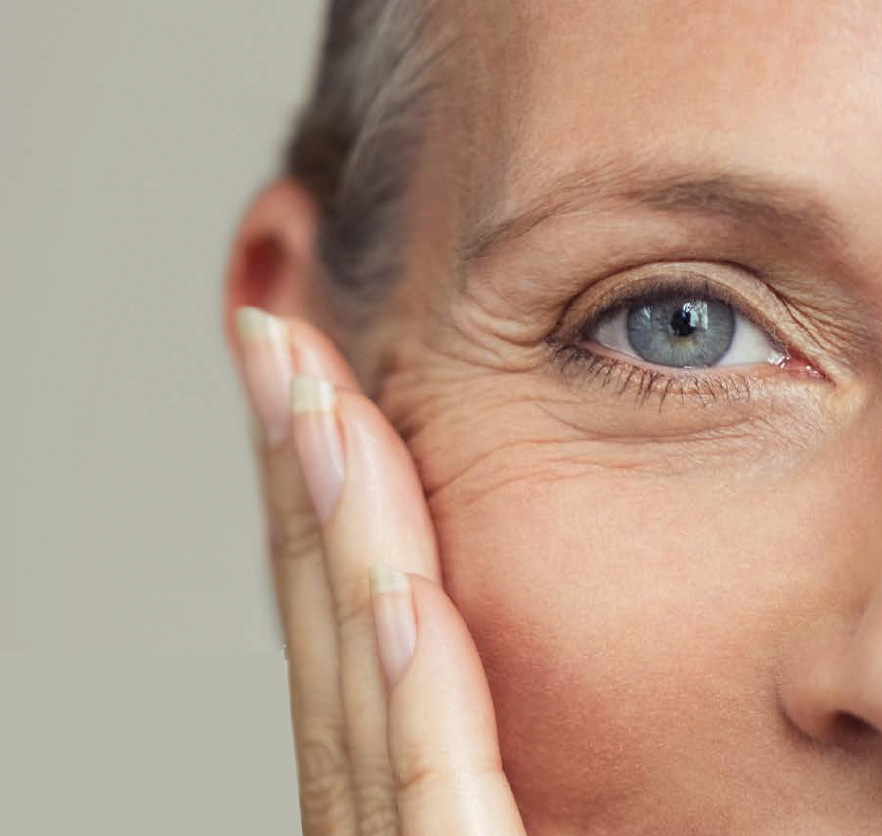Dr Jean-Marc Chardonneau
“I’d just turned sixty when the face I encountered at least once a month in the mirror suddenly appeared foreign to me.”
Anthropologist David Le Breton pinpoints how we feel about our body as we age, highlighting how we become aware that the most intimate part of ourselves is fading away. Modern-day society, by making wellbeing a priority, is trying to alleviate this disjunction.
Today, facial rejuvenation boasts a number of therapeutic options.
 People of a certain age prefer to undergo treatments that are as minimally invasive as possible while still being effective. Microvibration, an innovative and highly relevant technology, ties in perfectly with this desire. Using vibrations for therapeutic purposes is nothing new. At the end of the 19th century, Jean-Martin Charcot developed a vibrating wheelchair (inspired by railway journeys) designed for people with “shaking palsy” (Parkinson’s) as well as a vibrating helmet.
People of a certain age prefer to undergo treatments that are as minimally invasive as possible while still being effective. Microvibration, an innovative and highly relevant technology, ties in perfectly with this desire. Using vibrations for therapeutic purposes is nothing new. At the end of the 19th century, Jean-Martin Charcot developed a vibrating wheelchair (inspired by railway journeys) designed for people with “shaking palsy” (Parkinson’s) as well as a vibrating helmet.
During the Great War, “Granville’s hammer” was used on the painful stumps of amputated limbs. The use of vibrating platforms by Russian Olympic coaches in the 1970s, followed by the Russian space agency, was popularised in the late 1900s with the appearance of power plates in gyms, followed by the Sismodermie machine. Developed by a team of Italian resear-chers and backed up by a number of stu-dies, endosphere therapy – a new technology that uses microvibrations – is the perfect addition to the arsenal of aesthetic medicine treatments for the face and body.
Endosphere therapy uses a device that contains 55 rotating silicone spheres (photo 1) set in a honeycomb pattern. This rotation creates microvibrations.
PHYSIOLOGICAL EFFECTS OF COMPRESSIVE MICROVIBRATION
- Activates the metabolism Microvibration therapy, like all acoustic waves, brings about the release of vasoactive substances: NO (nitric oxide) radicals and Vascular Endothelial Growth Factors (VEGF). These substances lead to hype-raemia in all of the tissue layers, including the conjunctive tissue, through vasodilation and vascular neoformation. This increased arterial flow leads to improved tissue oxygenation and stimulates the production of fibroblasts, and therefore the appearance of collagen and elastin fibres.
- Increases lymphatic flow As the skin ages, the macromolecules’ interaction with en-vironmental factors and the alteration of the synthesis and breakdown processes affect hydric homeostasis in the tis-sues and, consequently, their function. This is aggravated by reduced lymphatic flow. The microvibrations encourage the lymphangions to contract and therefore accelerate lymphatic flow. This leads to a progressive pumping action which balances out the liquids in the tissues and restores the ex-tracellular matrix.
- Fibrolytic action According to Young, wrinkles are the result of mechanical instability between the skin’s layers. The way in which the reticular dermis and the subcutaneous tissue stick together is directly responsible. But, these different adherences greatly depend on the fibrous nature of the subcutaneous tissue. The more fibres there are in the subcutaneous tissue, the higher the risk of wrinkles appearing. Fibrosis is reduced by microvibrations and compression.
- Muscle-relaxing action Facial aging is associated with the shortening of the muscle fibres. The muscles in the face get shorter with age. They lose their domed shape to become rectilinear. Endosphere therapy (photo 2) relaxes and releases any ten-sion in the muscles, which is why the face looks relaxed and toned after the treatment.
IN PRACTICE
The device is equipped with three handpieces, each one with a specific function. Years of research and experience led to the development of EVA, this latest-generation technology. It is a comprehensive treatment protocol for facial rejuvenation.
It is made up of 3 phases:
Phase 1: Ablative microvibration This is a sort of peel or superficial dermabrasion. It promotes cell regeneration.
Phase 2: Compressive microvibration Erases wrinkles, stimulates the production of collagen and elastin fibres, and firms up the oval of the face.
Phase 3: Electroporation Reduces under-eye bags and dark shadows, evens out the complexion and makes the skin firmer. The treatment is well tolerated, particularly in terms of pain. No downtime is required. In general, 3 to 5 sessions are recommended. Each session lasts 45 minutes. Patients should have 1 to 2 sessions per week.
RESULTS
We see a clear improvement in the skin quality, fine lines disappear and wrinkles are erased. This 100% non-invasive treatment boasts clinically-proven results. It acts deep inside the tissues by relaxing and toning the facial muscles and preventing the tissues from sagging, as well as acting upon the cutaneous layers. Endosphere therapy can, of course, be used on its own or combined with other common facial rejuvenation treatments.
OTHER USES OF ENDOSPHERE THERAPY
In aesthetic medicine, as well as for facial rejuvenation, it is extremely useful for treating cellulite, localised fat stores and scars. In vascular medicine, lymphoedema, lipoedema and oedema can also benefit from this therapy. In sports medicine, it offers a large number of benefits.
 Dr Jean-Marc Chardonneau: Angiology graduate from the French National College of Aesthetic Medicine. DIU (inter-university degree) in obesity, aging and aesthetics of the superficial tissue (Paris V). Graduated in Phlebology from the Paris V Marie Curie Institute and the French National College of Aesthetic Medicine (Paris VI). Inventor of the microsculpture and mesocannulation techniques for the legs. Consultant for fCare, Solidea, Cutera servier, etc.
Dr Jean-Marc Chardonneau: Angiology graduate from the French National College of Aesthetic Medicine. DIU (inter-university degree) in obesity, aging and aesthetics of the superficial tissue (Paris V). Graduated in Phlebology from the Paris V Marie Curie Institute and the French National College of Aesthetic Medicine (Paris VI). Inventor of the microsculpture and mesocannulation techniques for the legs. Consultant for fCare, Solidea, Cutera servier, etc.












